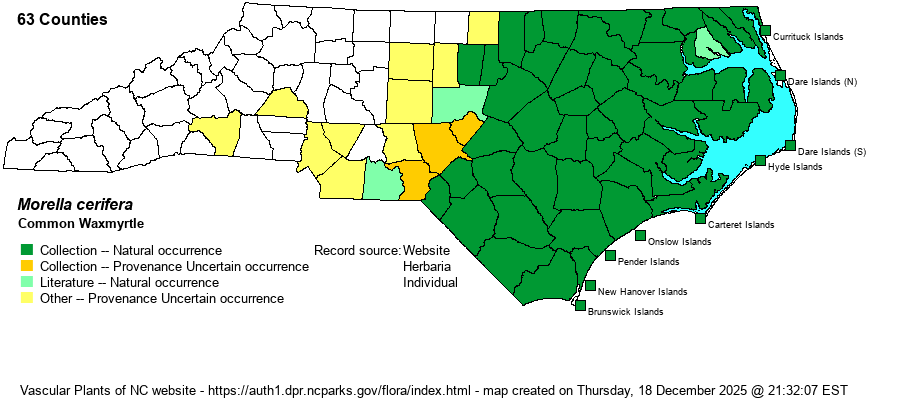| Section 6 » Order Myricales » Family Myricaceae |
Show/Hide Synonym
| taxonName | relationship | relatedTaxonName | relatedTaxonRefText | relComments |
|---|
| Morella cerifera | < | Myrica cerifera | Gleason and Cronquist (1991) | | | Morella cerifera | < | Myrica cerifera | Flora of North America (1993b, 1997, 2000, 2002a, 2002b, 2003a, 2004b, 2005, 2006a, 2006b, 2006c, 2007a, 2009, 2010) | | | Morella cerifera | < | Myrica cerifera | Godfrey and Wooten (1979, 1981) | | | Morella cerifera | < | Myrica cerifera | Wunderlin & Hansen Flora of Florida (3) | | | Morella cerifera | = | Myrica cerifera | Fernald (1950) | | | Morella cerifera | = | Myrica cerifera | Gleason (1952) | | | Morella cerifera | < | Morella cerifera | | | | Morella cerifera | < | Morella cerifera | | | | Morella cerifera | < | Morella cerifera | Kubitzki in Kubitzki, Rohwer, & Bittrich (1993). | | | Morella cerifera | = | Cerothamnus ceriferus | Small (1933, 1938) | | |
|
| Morella cerifera | = | Myrica cerifera var. cerifera | Radford, Ahles, and Bell (1968) | | | Morella cerifera | = | Myrica cerifera var. cerifera | | | | Source: Weakley's Flora |
|
| Author | (L.) Small | |
| Distribution | Throughout the Coastal Plain, and present in the extreme eastern and southeastern Piedmont, inward to Orange and at least Anson counties. Spreading westward into the central and southwestern Piedmont in recent years; in this region, best considered of uncertain original provenance. Taxon Editor Sorrie believes it to be probably native in eastern/southern portions of Harnett, Cumberland, Hoke, and Scotland counties, but planted and adventive in Richmond, Moore, and Lee counties, where no populations occur in natural habitats.
This is a mainly Coastal Plain species, ranging north to NJ, and south to the Gulf Coast in FL and eastern TX. It does range well north inland in AL MS, and AR.
| |
| Abundance | In the Tidewater zone, it is abundant and found very easily. Common to abundant elsewhere in the Coastal Plain away from tidal water. Uncommon in parts of the eastern Piedmont, such as Wake County. It is possible that the species is adventive in the Piedmont, and even western parts of the Sandhills proper, or at least spread into these provinces by birds excreting the seeds; it may originally have been restricted to the flat portions of the Coastal Plain. | |
| Habitat | This species is ubiquitous around the edges of salt and especially brackish marshes, and as an understory plant in pine stands or wet thickets and maritime forests, close to tidal areas. Farther inland it is often found in pools, marsh edges, swamps, and damp pinelands, but less often in pocosins and streamheads, though it can be found in most any kind of wetland habitat. It does occur into more mesic pinelands, and in the Piedmont it seems most numerous in pine stands, especially in Loblolly Pine (Pinus taeda) stands. | |
| Phenology | Flowers mainly in April, and fruits from August to October. | |
| Identification | This is a tall shrub, often considered as a small tree as well, ranging to about 12-20 feet high -– the tallest of the Morella species. It has alternate, evergreen leaves that are narrowly lanceolate, with a few sharp teeth toward the tip, as do other Morella species. It can be separated from both Morella caroliniensis and M. pensylvanica by its thinner and narrower leaves; they are about 2.5-3 inches long, but always less than an inch wide, more often about 2/3-inch wide. The twigs tend to be light gray, paler than in the other two; and the fruits are also smaller. Normally, this shrub is easy to identify, as it is so abundant in coastal areas and present at sites where the other two are not found (such as tidal areas south of Dare County). But, care must be taken in coastal Dare County, with M. pensylvanica, and in freshwater wetlands, with M. caroliniensis. | |
| Taxonomic Comments | All Morella species were, until recently, included in the genus Myrica -– i.e., Myrica cerifera. RAB (1968) and some other references have the species split into the nominate var. cerifera and the small-stature form -– var. pumila. Some references do not have these forms broken out at all, whereas Weakley (2018), this website, and perhaps a few others have these forms split as separate species.
| |
| Other Common Name(s) | The species is usually simply called Waxmyrtle. However, with the elevating of Morella pumila to full species status by some entities, including here, it is best (and proper) to give a modifier name to M. cerifera -– in this case Common Waxmyrtle -– to avoid confusion. Other names include Southern Bayberry (confusing, with M. caroliniensis also called this), Candleberry, Bayberry-tree, Tallow-shrub | |
| State Rank | S5 | |
| Global Rank | G5 | |
| State Status | | |
| US Status | | |
| USACE-agcp | FAC link |
| USACE-emp | FAC link |

